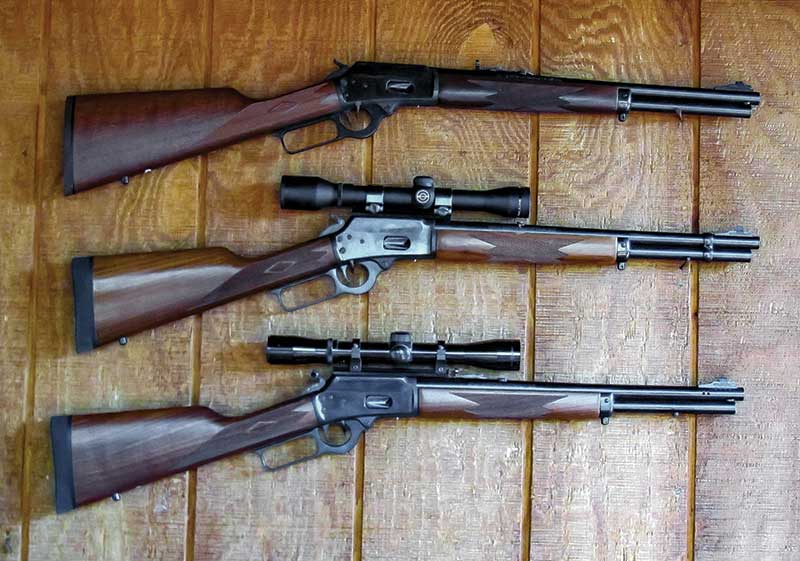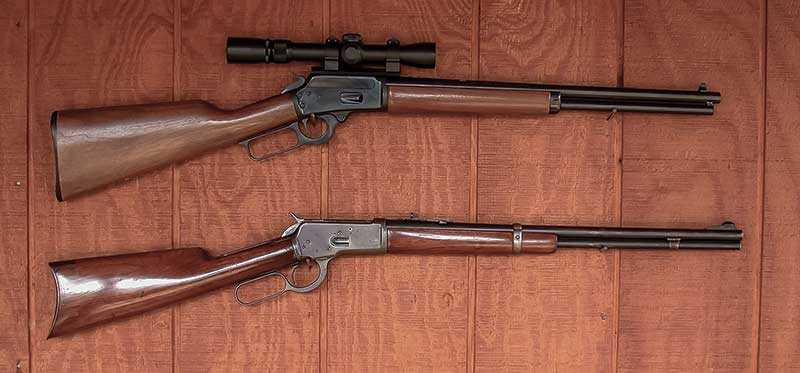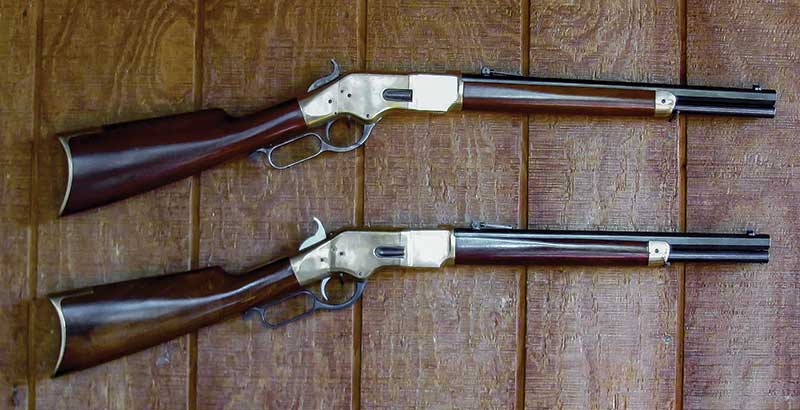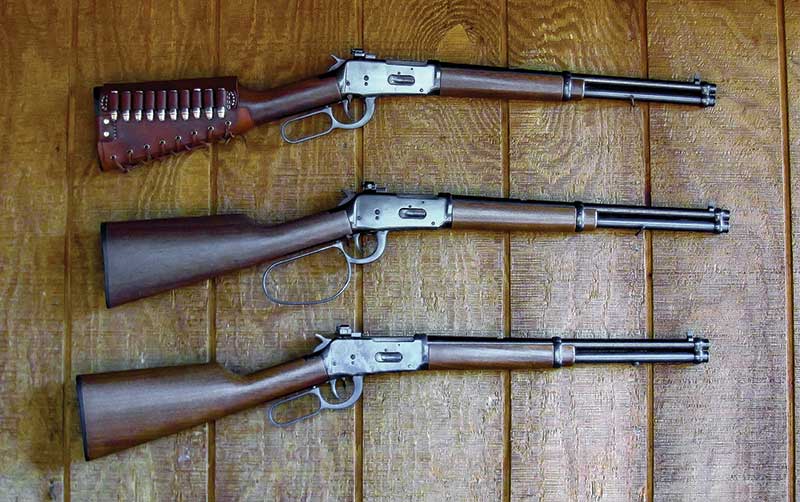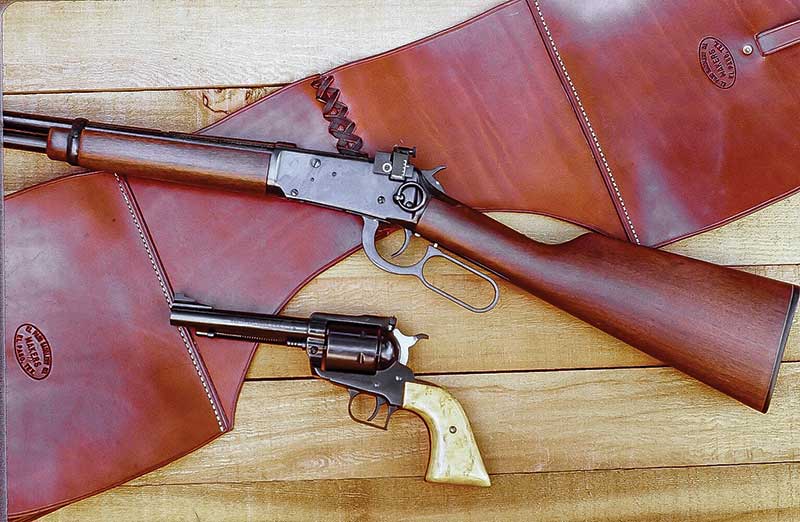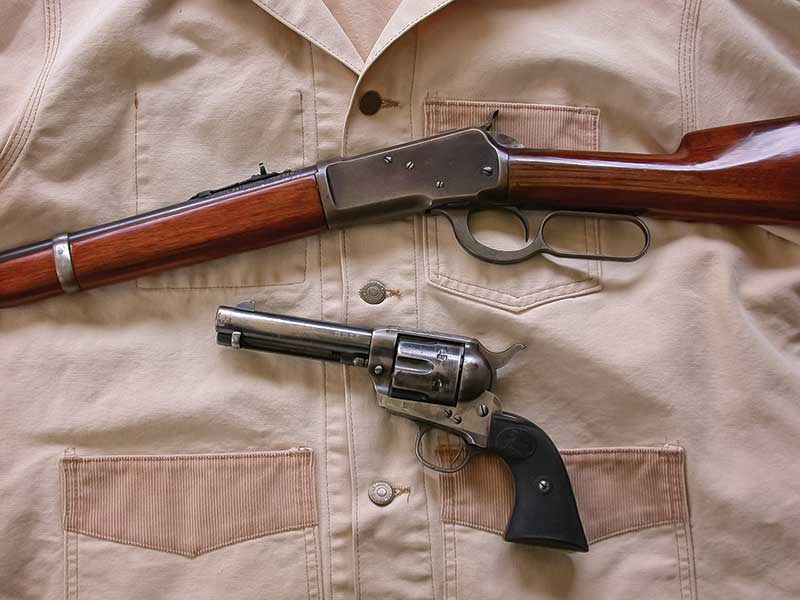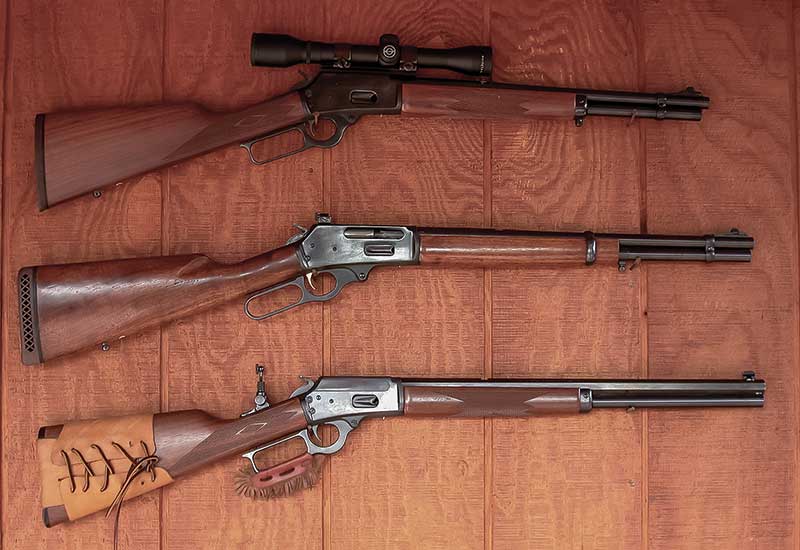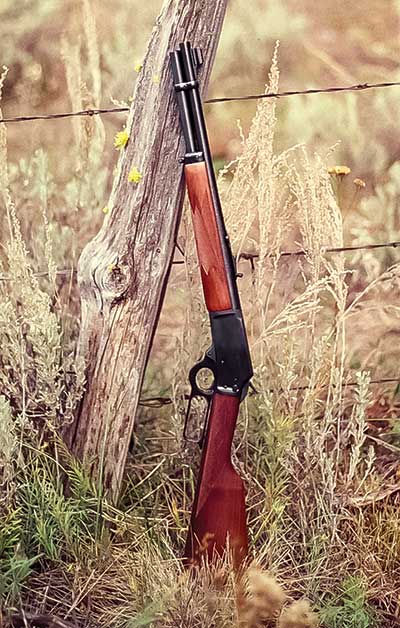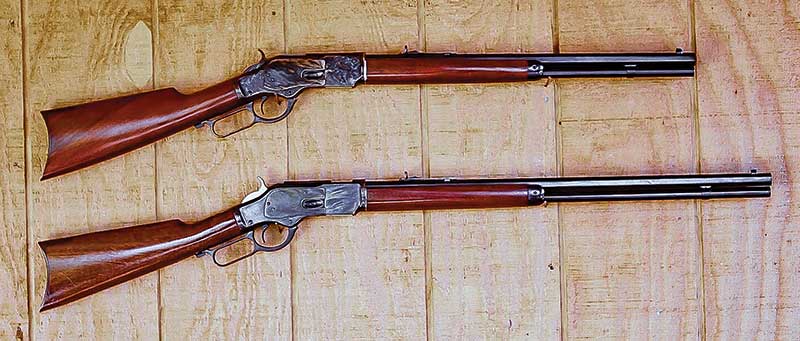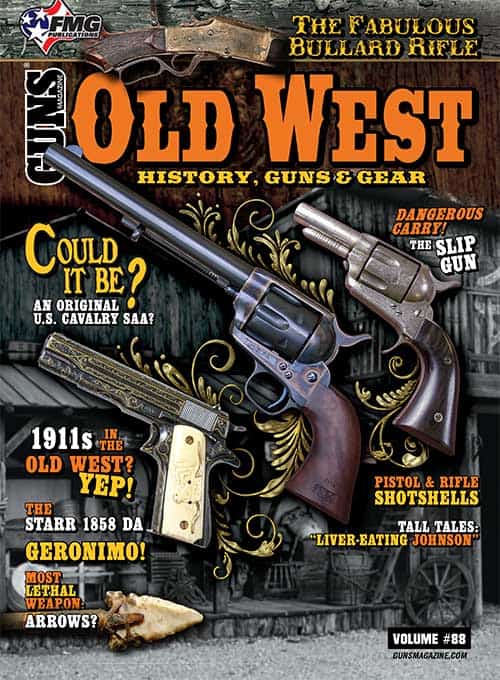Slick Actions
Real Pistol-Caliber Carbines Have Levers!
Much attention has been given recently to pistol-caliber carbines, especially AR-type rifles and pistols chambered in 9mm. So much attention, in fact, some might think it’s a new idea. Not quite. Carbines chambered in pistol-length cartridges go back well over 160 years.
Pistol Origins
The very first attempts, some more successful than others, to come up with a repeating firearm involved pistol-length cartridges. The first successful repeater, the Model 1860 Henry, was chambered in the .44 Rimfire — definitely a cartridge that proved to be suitable for chambering in sixguns. The Spencer arrived about the same time as the Model 1860 Henry, and it also featured a pistol-length cartridge. The Model 1860 Henry was improved to the Model 1866 Winchester and was still chambered in the same .44 Rimfire. Late 1869, S&W came forth with the first successful big-bore cartridge-firing revolver chambered in the .44 S&W American, a centerfire cartridge. It was also chambered in the .44 Rimfire.
1873 saw the arrival of the first Center-Fire Winchester with the Model of 1873 chambered in .44 Winchester Centerfire (.44 WCF), or as it is most commonly called today, the .44-40. The same year, Colt issued its Single Action Army in .45 Colt. Prior to this, Colt cartridge conversions were available in .44 Colt and many believe the first Single Action Army was actually chambered in .44 Rimfire.
I recently read in another magazine the Winchester 1873 was chambered in vintage revolver rounds. Actually, this is backward! Winchester went on to chamber the 1873 in a necked-down .44-40, the .38 WCF, followed by a small-bore cartridge, the .32 WCF. These are more commonly known today as the .38-40 and .32-20. They were originally rifle cartridges. Colt chambered the Single Action Army in all three of the Winchester Centerfire cartridges, however, they all arrived first in lever-action carbines. Winchester also necked-down the .32-20 to come up with the .25-20, but Colt did not chamber its Single Action Army in this dandy little cartridge.
No .45 Colt?
At the time, Winchester did not chamber their lever-action Model 1873 in .45 Colt for a couple reasons that seem obvious. One problem would be feeding. The .45 Colt is a straight-wall cartridge, while the .44-40, .38-40 and .32-20 are all bottleneck cartridges, making them much easier to feed from the action into the chamber. Another reason relates to the rims. The original rim was very small, without much area for an extractor to grab. I recall reading handloaders’ complaints in the 1940s-’50s of rims pulling off when cases were re-sized, giving birth to the myth of weak .45 Colt brass. Even today, the .45 Colt cartridge, which has a larger diameter case than the .44 Magnum, has the same size rim. An improvement in modern brass is the channel cut around the base of the cartridge case right in front of the rim which allows a better grasp by the ejector. Even so, I don’t believe any lever-action carbines were chambered in .45 Colt until quite a while after both Marlin and Winchester chambered the .44 Magnum in the mid-to-late ’60s.
Slick As A …
One of the great attributes of the 1860s/1866/1873 Winchesters was how smoothly they operated. They are very particular about overall case length, however with the right ammunition, it is almost a spiritual experience working the lever of one of these great guns. Today’s replicas work exactly the same way. These first leverguns could easily be operated without removing the butt from the shoulder and this is true of most modern leverguns, too. Keep the butt on the shoulder and work the action with authority.
What’s Old is New
After the 1873 Winchester, the Models 1876 and 1886 arrived chambered in what we normally think of as rifle cartridges, such as the .45-60 and .45-70. Then in 1892, Winchester went back to their pistol-length roots modernizing the 1873 Winchester into what is basically a miniaturized Model 1886 but chambered in the same cartridges as the Model 1873 Winchester. The Model 1892 proved to be one of the slickest handling and strongest lever-action carbines of all time.
Modern-Era Levers
The real modern era of lever action-style PCCs began in the early 1950s. Ward Koozer, a gunsmith in Arizona, began converting .32-20 Winchester Model 1892s to .357 Magnum. One of my favorite articles was by Kent Bellah featuring his sixgun/levergun combination consisting of a 3 1⁄2″ S&W .357 Magnum and a Koozer-converted Model 1892.
I believe the first lever-action-style Magnum pistol-caliber carbines factory produced were the Winchester 1894 and the Marlin 336 both chambered in .44 Magnum in the late 1960s. In 1969, the old Marlin 1894 was resurrected and offered in .44 Magnum, and then later in .44-40. This action, being shorter, is better suited to sixgun cartridges than the .30-30 length 336 action. Marlin also made a special run of Trapper-style 1894 carbines in .44 Magnum and .45 Colt with a 16 1⁄4″ barrel; full magazine tube that holds seven or eight rounds depending upon the nose length of the bullet; a recoil pad on its straight gripped stock; checkering on forearm and buttstock, and excellent sights.
Winchester would also go on to chamber their Model 1894 in .45 Colt and .357 Magnum offering both in Trapper versions. In the 1970s, Marlin introduced their Model 1894C chambered in .357 Magnum. This is one of the handiest carbines ever offered and our family has four of them currently in use. Marlin also chambered this little carbine in .32 Magnum, .32-20 and .25-20, and since they did not come up with one in .327 Magnum I had my local ’smith convert one of the .32 Magnums to this longer cartridge.
Modern Cowpokes
One of the great benefits of Cowboy Action Shooting is the resurrection of so many classic Winchesters all chambered in pistol-length cartridges by Uberti. All three of the original Winchesters, Models 1860, 1866, and 1873, have been offered in the original three chamberings as well as .45 Colt and .357 Magnum. And now the Model 1873 is even available in .44 Magnum. The .38 Special can also be found, and two of my favorite easy-shooting PCCs are the replica Model 1866 chambered in .38 Special as well as a very rare .44 Special.
In the period between the two World Wars, El Tigre 1892 .44-40 carbines were produced under a license from Winchester in South America. In the 1950s, these could be purchased for $39.95. I waited 50 years too long and had to pay more than 20 times as much to get an excellent example. The bonus is it outshoots my original Winchester 1892. In the 1980s, I believe, the first examples of the excellent Rossi replicas of the Model 1892 began arriving. These have been offered in .44-40, .44 Magnum, .45 Colt and .357 Magnum. I recently purchased a stainless steel version of the latter and had the barrel cut back to 16 1⁄4″. I added a Lyman Model 66A receiver sight and had the stock refinished to make it a weather-beating match to the stainless steel finish. This could easily be the
Perfect PCC.
About the same time Rossi was bringing forth their replica 1892s, Browning also offered the Model B92 chambered in .357 Magnum and .44 Magnum. These are beautifully fitted and finished PCCs and worth looking for on the used-gun market. Uberti has also offered a long lineup of Replica Model 1892s in several barrel lengths, including those with octagon barrels and chamberings such as .45 Colt and .44 Magnum. Winchester also now offers their Miroku-produced Model 1892 in most chamberings at various times including .38-40. These are also beautifully fitted and finished, perhaps even better examples than the originals.
Currently, Henry Repeating Arms also offers PCCs chambered in .357 Magnum, .44 Magnum and is the only manufacturer to offer a .327 Magnum version. I recently purchased three lever-action .357 Magnum carbines from three different manufacturers. Two of them had very heavy trigger pulls of 7.5–8 lbs., as well as somewhat gritty actions. They were usable as is. However, I had to have both of them smoothed with the trigger pulls reduced to satisfy my levergun-shooting soul. I can do pretty good work with heavy trigger pulls, but it takes a lot more concentration. The Henry .357 Magnum was ready to go right out of the box.
PCC Calibers Galore
I recently took stock of what lever-action-style PCCs I have had extensive experience with and came up with the following chamberings in Marlin, Winchester, Browning, Rossi, Uberti and El Tigre leverguns. In order from smallest to largest those are: .32 Magnum, .32-20, .327 Magnum, .38 Special, .357 Magnum, .38-40, .41 Magnum, .44-40, .44 Special, .44 Magnum and .45 Colt. I was even able to fire the original .454 chambered Winchester 1894 as well as a comparable Marlin. Both actions proved to be inadequate to handle the high pressures of the .454, however Rossi did make it work. None of these .454s can be called pleasant to shoot. Bighorn Armory now offers their lever action in both .500 S&W (not really a pistol-length cartridge) and .475 Linebaugh. At this stage of my life, however I might really like to experience them, this is a case where the spirit is willing, but the flesh is weak.
My favorite rifles are leverguns, and my favorite leverguns are the Trappers with barrel lengths of 16 1⁄4″. Before the government in its infinite wisdom made shorter lengths illegal, factories offered barrel lengths such as 12″ and 14″ — which would certainly be exceptionally handy. My all-around Perfect Rifle is a PCC levergun chambered in .357 Magnum and outfitted as the above-mentioned stainless steel Rossi. Properly loaded, it also makes a very effective home-defense rifle — especially in such a situation I appreciate the fact I’m in control of loading the next cartridge into the chamber.
There is nothing I am likely to encounter in my area that cannot be handled with a .357 Mag. levergun such as this, and if I ever wander into a more challenging environment, I can always reach for a Trapper in .44 Magnum or set up for Heavy .45 Colt.
